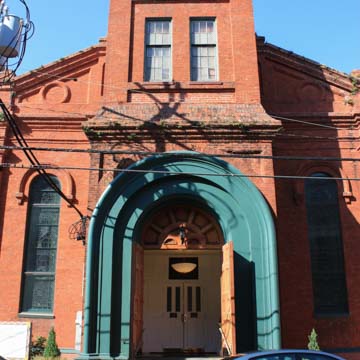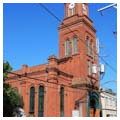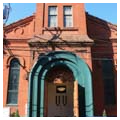Carpenter and builder Daniel Mulligan (1821–1874) emigrated with his brother, builder Thomas Mulligan (1823–1877), from Ireland. This bright red brick church, with a tall, massive square tower marking the center of the facade, is a major landmark in a neighborhood of small one- and two-story wooden houses. The mostly French-speaking congregation was formed in 1838 and worshiped in a wooden structure until the new church was built. The entrance portal at the base of the tower is a monumental arched opening, vigorously outlined by multiple rounded moldings. Although the bell tower’s upper stage was probably intended from the beginning, it was not built until 1924. Inside the church, Corinthian columns, which were added in 1923 to reinforce the superstructure, reached to colorful scenes depicting events in the life of St. Vincent de Paul, painted across the shallow-arched barrel vault c. 1907 by Italian-born New Orleans artist Achille Peretti (c. 1857–1923). In 2003 a fire destroyed much of the interior, including the murals, but not the French and American-made stained glass that fills the tall paired round-arched windows. The interior was restored but not the murals. In 2001, the church was amalgamated with three other churches to form a new parish.
You are here
Blessed Francis Xavier Seelos Catholic Church (St. Vincent de Paul Catholic Church)
If SAH Archipedia has been useful to you, please consider supporting it.
SAH Archipedia tells the story of the United States through its buildings, landscapes, and cities. This freely available resource empowers the public with authoritative knowledge that deepens their understanding and appreciation of the built environment. But the Society of Architectural Historians, which created SAH Archipedia with University of Virginia Press, needs your support to maintain the high-caliber research, writing, photography, cartography, editing, design, and programming that make SAH Archipedia a trusted online resource available to all who value the history of place, heritage tourism, and learning.


















